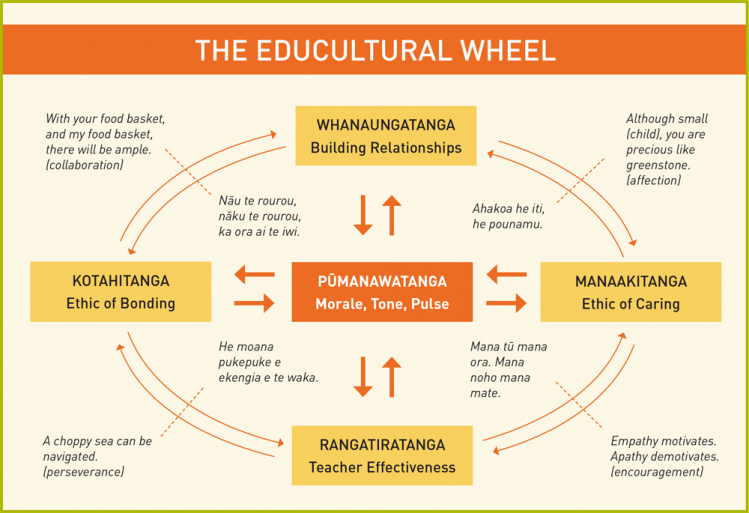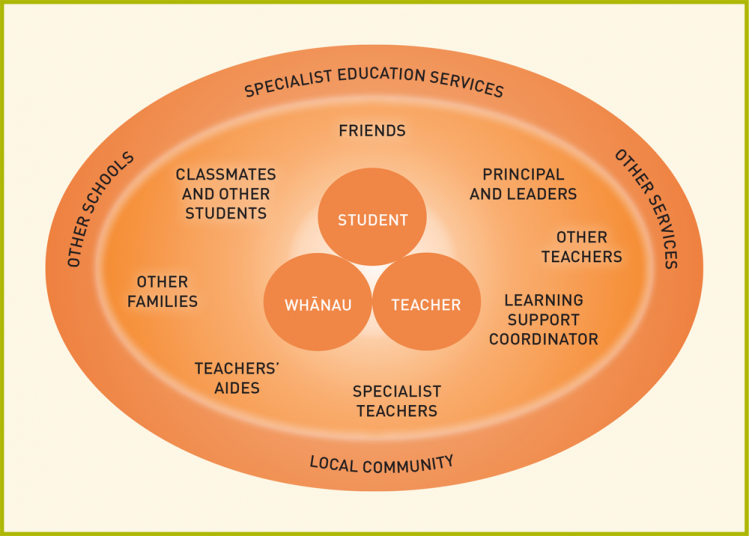Working together is about building a school community and a culture where people are welcome and feel able to be involved.
People talk about "school" and "community" as if school is outside of or separate from the community. I think we should talk about "the school community" – where families feel they can come and go; where families are involved and know about the learning; when whānau can feed into the curriculum. When these things happen, and all groups are participating more fully, then they are working together as a community. The school needs to be good at breaking down that invisible wall.
Academic, project interview, 2013
The school culture
The culture of the school is the climate in which people work together. For a positive and supportive school climate, team members and the wider community need to work together in inclusive, collaborative, and culturally responsive ways. Macfarlane’s (2004) Educultural Wheel provides a useful framework to conceptualise this approach.
The wheel is a visual representation (see Figure 2), showing the interactions between four dimensions (unpacked below) and how these ultimately contribute to inclusive practice, effective pedagogy, and pūmanawatanga (overall tone, pulse, and morale).
Figure 2: The Educultural Wheel1
Adapted from Macfarlane (2004)
If you cannot view or read this diagram, select this link to open a text version.
Whanaungatanga refers to the building of relationships and to bringing people together, uniting the school and the local community into a "school community". It is ultimately about building relationships, facilitating engagement, making connections, fulfilling obligations, and sharing responsibilities. It includes valuing others by making time and creating the spaces for engagement. It is about responding to students’ backgrounds and histories by truly listening to students and their whānau, reflecting Ballard’s (2013) view that effective inclusion depends on challenging established ideas about “how the world is to be seen and understood, about who is to be attended to and who ignored” (2013, page 1).
Whanaungatanga provides the relationship to contextualise what is in the heart of the matter, and then get to hear what is really in people’s hearts, rather than just what they think you want them to say. Until this happens you are having a totally different conversation, which is not likely to work for Māori.
Academic, project interview, 2013
Manaakitanga refers to showing hospitality and developing an ethic of care for others. It refers to a nurturing school culture that values caring and respect and provides the foundation for success for all students. The same ethic of care and respect applies to teachers and whānau. Building trust through caring and supportive relationships plays a key role in establishing inclusive practice in which everyone feels a sense of belonging and knows that their knowledge and opinions are respected and valued. Everyday actions – for example, greetings and farewells, staying in touch, noticing and celebrating the good things, and showing hospitality, affection, kindness, and encouragement – affirm manaakitanga as an integral part of the culture of a school.
Kotahitanga refers to achieving unity by coming together to collaborate and bond as a united group (whānau). For learners to succeed and reach their potential, the school, whānau, hapū, iwi, and the wider community must work together regularly (Ministry of Education, 2008). Students who have special education needs provide whānau, teachers, students, and others with many opportunities for bonding, uniting, and working together collaboratively.
Rangatiratanga refers to key aspects of teacher effectiveness. It is about leadership, accountability, authenticity, advocacy, determination, and integrity. It connects the passion and enthusiasm of teachers with others in a team. When people work together in collaboration, facing particular challenges and supporting and responding to one another, strong advocacy and leadership are essential. The effectiveness of the whole team in including all students in the school curriculum is enhanced when rangatiratanga is in place. School leaders also play a key role in supporting and ensuring teacher effectiveness.
It has to come from the top: walk a mile in their shoes, manage the expectations of teachers, make good use of specialists, deal with the (challenging) views of parents and the Board of Trustees. If you have the difficult conversations, you can focus on the benefits; you can focus on success.
Primary school principal, project interview, 2013
Pūmanawatanga refers to the overall tone, pulse, and morale of the school. The four dimensions above come together and interconnect to promote pūmanawatanga, by embracing the mana of each person, drawing on individual and collective strengths, seizing opportunities to enable potential, honouring uniqueness, and celebrating success for all students.
The Educultural Wheel is able to support you, and the teams you are part of, to think about how you might enact the above dimensions. It gives rise to valuable questions that guide the development of inclusive practice.
In pairs or small groups, reflect on examples from your teaching experience in relation to the four whakataukī below from the Educultural Wheel. Share stories illustrating beliefs and actions that link to the values each whakataukī expresses.
- Affection – Ahakoa he iti, he pounamu. Although small (child), you are precious like greenstone.
- Encouragement – Mana tū mana ora. Mana noho mana mate. Empathy motivates. Apathy demotivates.
- Collaboration – Nāu te rourou, nāku te rourou, ka ora ai te iwi. With your food basket, and my food basket, there will be ample.
- Perseverance – He moana pukepuke e ekengia e te waka. A choppy sea can be navigated.
Return to top
Networks of support
Every student is a member of the school community, known and supported by friends and peers, staff, whānau, and members of the local community. For students with special education needs, there may be additional people and agencies that form part of their network of support. Figure 3 shows the people and agencies that work together within this network.
Figure 3: The network of support for students with special education needs
If you cannot view or read this diagram, select this link to open a text version.
Every school, teacher, class, and student is unique. However, as figure 3 shows, at the centre of the network of support the relationships between the student, their whānau, and their teacher provide a key foundation for teaching and learning. Knowledge from these relationships assists you to meet the learning needs of each student in your class and helps you understand who else you may need to involve in supporting them. Support can look different, depending on particular learning needs and the context.
Figure 3 shows how the student (and teacher and whānau) are supported by the school community, particularly those involved in the day-to-day teaching and learning within the school. This includes the principal and other leaders, classmates and other students, teachers’ aides, other teachers, the Learning Support Coordinator or SENCO, other families, and specialist teachers (see the table below).
A wider group, outside of the immediate school environment, may include people from the local community such as kaumātua and from other schools, such as The Regional Health School or Te Aho o Te Kura Pounamu: The Correspondence School. It may also include staff from Ministry of Education specialist education services and other services, examples of which are given in the table below. The information these people provide can support planning and the use of assistive technology and help everyone to understand a student’s strengths and learning needs. If during planning a school has decided that an IEP is required to meet a student’s support needs, the plan will outline the services supporting the student. It will also provide clarity and agreement about the different responsibilities of support team members within and from outside the school.
| Broad term
| Examples of roles that the term includes
|
|---|
| Specialist teachers2
| School-based 0.1 or 0.2 ORS-funded teachers Teachers from Outreach Teacher Services RTV (Resource Teachers: Vision) RTD (Resource Teachers: Deaf) RTLB (Resource Teachers: Learning and Behaviour) RTLit (Resource Teachers: Literacy) Teachers from residential schools Teachers from regional health schools
|
| Specialist education services
| Ministry of Education, Special Education:
- Advisors on deaf children
- Kaitakawaenga
- Occupational therapists
- Physiotherapists
- Psychologists
- Special education advisors
- Speech language therapists
|
| Other services
| Child, Youth and Family Child & Adolescent Mental Health Service ACC
|
In Example 2, a year-5 student and his teacher are supported by staff from within the school (a specialist teacher and teacher’s aide) and by specialists from the local Ministry of Education office.
When services from outside the school are involved, it is important that school staff and agencies understand how to work together collaboratively, and that student presence, participation, and achievement remain the core focus of the collaborative team.
Schools need to show leadership around meeting the needs of all students. This means being aware of who from the above groups is best suited to help them in their planning and teaching. They should make themselves aware of the purpose of each role and how they can access the support they need to provide an inclusive curriculum.
In Example 11, a student and his year-13 history teacher are supported by staff from within the school (the Learning Support Coordinator and a teacher’s aide) and by a visiting specialist.
[1] The Educultural Wheel is usually applied in relation to the classroom. This section applies it more broadly to the school.
[2] The first four examples of specialist teacher roles are provided through a school’s 0.1 or 0.2 staffing component for a student supported through ORS funding.
Next – Working in a team
Published on: 19 May 2015
Return to top





